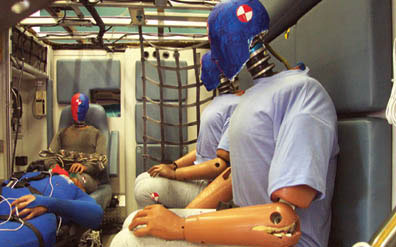NIOSH Continues Research to Improve Safety for Ambulance Service Workers and EMS Responders
August 2011
DHHS (NIOSH) Publication Number 2011-190

Developmental testing conducted with instrumented crash test dummies. Photo courtesy of NIOSH.
A Story of Impact:
Transportation incidents are the leading cause of work-related deaths in the United States; between 2003 and 2009, an average of almost 1,300 U.S. workers died from roadway crashes each year. The risk is even greater for emergency medical services (EMS) personnel. In 2002 field investigators estimated that the fatality rate for EMS workers was more than 2 times the national average for all workers.2
As part of the National Occupational Research Agenda (NORA), researchers at the National Institute for Occupational Safety and Health (NIOSH) set out to reduce ambulance crash–related injuries and deaths among EMS workers. Research addressed the layout and structural integrity of ambulance compartments, design of hardware, and occupant restraints.
NIOSH research revealed a number of important factors involved in ambulance worker injuries and deaths. For example, field investigators observed that EMS workers often ride on the squad bench without wearing a restraint. This allows them to lean forward, stand up, or change positions as needed to reach the patient or equipment, but places them at higher risk of striking bulkheads, cabinets, shelves, or other occupants during a crash. NIOSH crash tests also revealed the possibility of head injury if a worker’s head strikes the cabinets immediately above or behind them, and noted that vehicle structural failures can be a contributing factor in adverse outcomes of EMS crashes.
Relevant Information
- About 218,000 emergency medical technicians and paramedics were employed in 2009, according to the Bureau of Labor Statistics.4
- Between 500,000–800,000 workers are estimated to volunteer as emergency medical technicians or paramedics in addition to the 218,000 employed personnel. These figures do not include the many additional firefighters who are also trained in emergency medical services.5
Impact
NIOSH researchers continue to work with AMD-NTEA, GSA, manufacturers, and federal agencies on other recommendations to improve occupational safety for EMS workers. Ongoing efforts include creating and validating individual standards for seating and worker restraints, litter and patient restraints, and equipment mounting. These research-to-practice measures and collaborative efforts will improve the safety of EMS crew members in their mission to save the lives of others.
View/Download Entire Document: NIOSH Continues Research to Improve Safety for Ambulance Service Workers and EMS Responders [PDF – 2,320 KB]




Authors of Partnering with Industry to Build Safe EMS Work Environments—James Green and Paul Moore; Division of Safety Research; NIOSH—won the 2011 Bullard-Sherwood award in the Intervention Category, and authors of the Ambulance Crash Survivability Improvement Project—Paul Moore, James Green, Richard Current, Thomas Bobick, and Nancy Romano; Division of Safety Research; NIOSH—received the 2009 Bullard-Sherwood Award in the Intervention category. This impact sheet updates DHHS (NIOSH) Publication Number 2010-164 and the associated project on EMS worker safety.
References
1 BLS [2009]. Census of fatal occupational injury charts, 1992-2009. All charts, census of fatal occupational injuries 2009. Washington, DC: U.S. Department of Labor, Bureau of Labor Statistics, Injuries, Illnesses, and Fatalities. [http://www.bls.gov/iif/oshcfoi1.htm].
2 Maguire B, Hunting K, Smith G, Levick N. [2002]. Occupational fatalities in emergency medical services: a hidden crisis. Ann Emerg Med 40: 625-632.
3 CDC (Centers for Disease Control and Prevention) [2003]. Ambulance Crash-Related Injuries Among Emergency Medical Services Workers – United States, 1991-2002, reported by Proudfoot S, Romano N, Bobick T, Moore P. MMWR 52(08); 154-156.
4 BLS [2009]. May 2009 National Occupational Employment and Wage Estimates, United States. Washington, DC: U.s. Department of Labor, Bureau of Labor Statistics, Occupational Employment Statistics [http://www.bls.gov/oes/2009/may/oes_nat.htm#29-0000].
5 LaTourrette T, Peterson D, Bartis J, Jackson B, Houser A [2003]. Protecting emergency responders volume II: community views of safety and health risks and personal protection needs. Arlington, VA: RAND [http://www.rand.org/pubs/monograph_reports/MR1646.html].
SAFER • HEALTHIER • PEOPLE™
